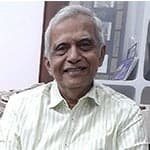
Sitting pretty on a hill in the heart of the Nallamala Forests is Srisailam, now bursting at the seams with devotees thronging it for the Mahasivaratri. It is much more than the abode of Sri Mallikarjunaswamy and His Consort, Sri Bhramarambika. It harbours many interesting aspects which a routine pilgrim is mostly likely to miss. For example.……….
A staggering half a million people trek through the Rajiv Gandhi Tiger Reserve during the run-up to Sivaratri and Ugadi festivals, a large chunk of them coming from Karnataka. The Kannadigas regard Sri Bhramaramba as their own daughter and Sri Mallikarjuna swamy as their son-in-law. Devotees from Karnataka account for a third of the footfall at the shrine.
Some devotees take strange vows. Over 40 summers ago, I chanced upon a devotee from Karnataka on the Kurnool-Srisailam road. For every step he took, he did sashtanga prananam on the hot tar road! This all the way to Srisailam!
The tiger sanctuary’s core area, normally out of bounds for public, remains open for the devotees on these occasions. The route through the core area is 70 per cent shorter. In the past, Chenchus, the age-old inhabitants of the Nallamalas, used to escort pilgrims through the forests. Men, women and children walk in large batches, braving vagaries of the weather and threat of wild animals, followed by vans laden with their belongings. They set up camps where do-gooders arrange food, water and medicines. The emerald forest reverberates to the growl of the tiger and other wild animals at night and to the chant of “Harahara Mahadev” and “Om Namaha Sivaya” during the day. The Chenchus, listed among the primitive tribal groups and still living in the food gathering stage of economy, also regard Sri Mallikarjunaswamy as their own and enjoy certain privileges at the shrine.
Srisailam is the only place to have both jyotirlinga (one of the 12 located across the country) and sakti peetham (one of the 18), a distinction not even Kasi can boast of. Another interesting and less known feature is the existence of dual agamas governing worship here. Sri Mallikarjunaswamy temple follows Veerasaiva agama where Veerasaiva or jangama priests perform the rituals. However, at Sri Bhramaramba shrine, smartha brahmins conduct the rituals. A tribute to the synchronous existence of divergent agamas.
Srisailam also follows the practice of dhooli darsan which enables pilgrims to offer worship without having ablutions, ‘dhooli’ indicative of dust. B. D. Jatti, Acting President of India at the time, had dhooli darsan.
Pagalankarana is a unique ritual integral to Mahasivaratri festivities. Traditionally, a group of weavers from Prakasam district weave an endlessly long cloth and offer 30 pagas (turbans) to the celestial couple at their wedding. The cloth is wound round the sikharam of the Lord’s vimana gopuram and passed round the Nandi idols on the maha mukhamandapam, virtually blanketing the shrine.
The covetous opportunity of doing this goes to an individual. Since the process requires him to mount the sikharam, above the idol of the principal deity, he has to do this remaining naked to preserve the sanctity of the shrine. Lights are switched off during the process. Over 10,000 devotees are allowed inside the temple to witness the sacred ritual.
Sri Adi Sankara is known to have composed his famous Soundaryalahari and Sivanandalahari at what is known today as phaladhara and panchadhara in Srisailam.
Sri Bhramarambadevi is known to have assumed the form of ‘bhramara’ (bees) to slay a demon. Devotees make it a point to cup their ear to the crevices in the sanctum wall to hear the drone of bees! Such is the belief.
Another story goes that Chatrapati Shivaji worshipped at the riverside shrine and was presented a sword by the Godess. The Maratha king built one of the four cardinal gopurams to the shrine in1677 A.D.
Not far away and right in the midst of the impenetrable core areas is the interesting shrine dedicated to Ishta Kameswari, so named because she readily fulfills the wishes (ishtamulu) of the devotees. A cascading stream adds to the scenic splendor of the place, a deceptively small shrine, managed by the Chenchus. Devotees need special permission of the Forest authorities to enter. Jeep is the only mode of conveyance to cover the 20-km stretch. The path is treacherous, strewn all the way with boulders as big as a football. The jeep fare is Rs 750 per head. Needless to say, only brave hearts – young, strong and healthy- venture.
Sri Sangameswara temple at Kudali, also in Kurnool district, is an important saivite kshetram. It is located at the confluence (koodali) of the Krishna, Bhavanasi and five other tributaries. The temple is completely submerged in the backwaters of Srisailam reservoir and surfaces during the summer when the waters recede. The Lord appears in the form of a wooden lingam.
Srisailam is thus home to many interesting places and spectacles.
Dasu Kesava Rao is a seasoned journalist who has worked, among several newspapers, with The Hindu and served as its Bureau Chief in Hyderabad.

